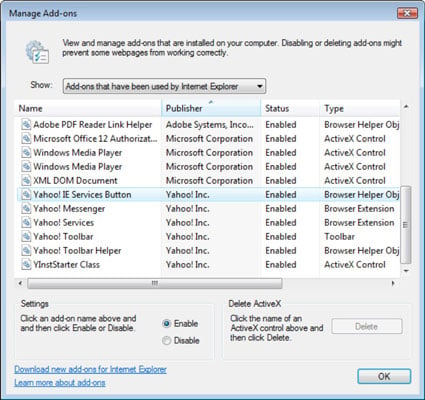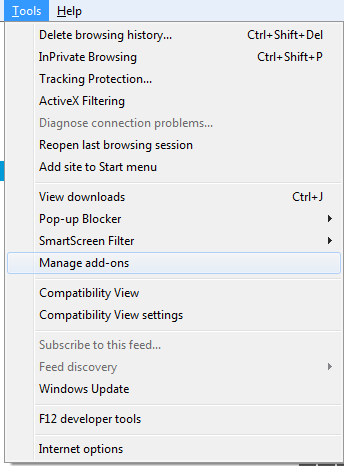Uninstalling Add-Ons in Internet Explorer (IE9) If you want to completely remove and uninstall an add-on from your browser, then you need to follow the same procedure that you would use to uninstall a regular program or application. You can read below to learn how to perform this task. If you just want to disable an add-on because you think you. There is a Group Policy however, called ‘Add-on List’ located under Computer Configuration Policies Administrative Templates Windows Components Internet Explorer Security Features Add-on Management. Here, you can add the Class ID and set the value to 0 for disabled, 1 for enabled, and 2 for enabled but users can disable/enable. Disable all add-ons at once by resetting Internet Explorer. If you're plagued with toolbars and add-ons, you can reset Internet Explorer to disable them all at the same time using the following steps. Click the gear icon. Click Internet options. Click the Advanced tab.
- Internet Explorer How To Delete Add Ons Safari
- Internet Explorer Disable Add Ons Command Line
- Internet Explorer Disable Add Ons Registry
- Allow Add Ons Internet Explorer

Adware is a software application, which displays unwanted advertisements automatically while running a program.
View Add-ons on your Internet Explorer Browser and disable or enable Add-ons. Open the desktop, and then tap or click the Internet Explorer icon on the taskbar at the bottom of the screen; Tap or click the Tools (gear) menu, and then tap or click Manage add-ons; Under the 'Show:' drop-down, tap or click All add-ons; Tap or click the add-on. Open Internet Explorer. Press Alt+X on the keyboard, or click in the top-right corner of the window. Select Manage add-ons. In the Show: drop-down list, select All add-ons. Select the extension that you wish to remove and click Remove. The extension will be removed from Internet Explorer.
Usually, the pop-up window appears as ads, which are generated by the adware. Thus, it hinders and annoys you now and then, as it keeps making endless pop-ups.
Not only that, but it can also lead to security risks, as some malicious or spying programs could also bundle with it.
Some of the intrusive threats associated with this are Computer Viruses, Worms, Trojans, Rootkits, spyware, and more. They perform various undesirable functions like stealing and deleting the data; hijacking core computing functions, and also monitoring the activities of the user without their consent.
Hence, if such programs infect your PC, then they can potentially slow down your device’s performance; consume the undesirably massive volume of data, as they download additional ads; and nevertheless, they can pave the way for the emergence of security threats that will allow tracking your activities online.
Therefore, as a solution we need to remove adware and pop-up ads from Windows 10, to avoid these issues. There are various methods to remove them; we are listing some below.
Procedures to Remove Adware and Pop-Up Ads from Windows 10
Method-1: Check for Add-Ons or Rogue Extensions in your Browser
The adware programs mostly settle in the form of extensions or add-ons in your browser. Removing them can also help get rid of such unwanted programs. Procedures for doing this in particular browsers are as follows.
Google Chrome
- Click the Chrome menu, at the top right corner of the browser; select More Settings and then click Extensions from the list of options it displays.
- Now, check if there are any unrecognizable extensions. If there is any unwanted or unknown extension, then remove them by clicking the Trash icon, next to it.
Internet Explorer
- Here, click the Settings icon, and select Manage add-ons option to view the installed list of add-ons.
- If anything looks unfamiliar in the list, then select it and click the Disable button that shows-up below.
Mozilla Firefox
- Get to the Add-ons menu, from the Firefox menu at the top right corner of the browser window.

- Then click the Extensions menu to the left, which will fetch of installed extensions. Check whether anything is unrecognizable, from the list. If you want to eliminate any of them, click the Disable or Remove button, shown below it.
Method-2: Check the Start Page, Search Engines, and other Defaults of your Browser
The other well-known tactics of the adware programs to take advantage of your browser is altering the Start Page, Search Engine settings. There is a lot of chances for making your browser prone to hijacking, by this way. Hence, it is better to ensure these settings to remove adware and pop-up ads from Windows 10. How to do this? Read on.
Google Chrome
- Go to the Settings window, and click the Set Pages option, under the On Startup segment. If any unknown website is put-up there, rather than a blank page or your specified page; then remove them with the help of the Settings button beside it.
- You can also verify the search engine settings, by selecting the Manage Search Engines options, under the Search Engine segment. Choose your preferred search engine Default, here.
Internet Explorer
- Choose the Settings icon and click Manage Add-ons. Here, select Search Providers option in the left pane and then the search engine, you want to use. Such as Google, Bing, etc. for example. If you notice any unwanted things, just select it and click Remove.
- Again in the Settings, select Internet Options, and look into the Home Page. If you find any unrecognized URL in this box, delete it and type-in your preferred website.
Mozilla Firefox
- Select the Options menu, from the Firefox menu. Then choose the Restore to Default button and click Ok to continue.
- To check the Search Engine settings, select the Search tab in the left pane and set your default search engine. If there are any strange things under One-click search engines segment, select it and click Remove.
Method-3: Check the Auto-Start Programs
Adware can also pin unwanted programs to the Start so that it evokes right away when you start your Windows 10 PC. To check and remove them from the Start settings, carry out the following steps.
- Right Click on the Start button and click on the Task Manager option to evoke it.
- In the oncoming window, select the Startup tab, to see the list of programs that are set to start when the PC boots.
- Check whether there is any adware. For disabling anything unfamiliar, select it and click the Disable button at the bottom of the window.
Method-4: Uninstall the Unnecessary Programs
If you still see any intrusive ads or pop-ups; then check if there is any unwanted software program installed in your system. For this, get into the Control Panel; click Programs, and then Programs and Features. Check whether there is any unrecognizable software in the list, shown in it. For uninstalling any software just double click on it and restart the PC, once it is uninstalled successfully. This procedure will certainly remove adware and pop-up ads from Windows 10 when done efficiently.
Method-5: Restore the System
If you are still not successful in removing the adware, then run a System Restore; to roll back the computer to the date when it worked properly. But for this, you should have set a restore point in your system, when it works fine. First, let’s see how to create a restore point.
- Type “system restore” in the Windows 10 Search box and select the Create a restore point from the oncoming suggestions. Now the System Properties dialog box will show up Get to the System Protection tab and then click the Configure button.
- Then enable the Turn on system protection option, and use the Max Usage slider to determine how much of the PC’s hard disk it can use to store the Restore Points. Usually, 5% to 10% is sufficient. After setting everything, click OK.
- If you want to return to a Restore Point: Open the System Properties dialog box again; get to the System Protection tab, and then select System Restore button and follow the instructions. You can also prefer the Scan for affected programs button before proceeding further.
Method-6: Download and Install MalwareFox Anti-Malware
If you are not satisfied with all the procedures mentioned above; and if the adware persists in your Windows 10 PC; then you have to deal it with a competent, protective software program. MalwareFox is one the best anti-malware, you can download it from its official website. It is a robust program that efficiently discovers and eradicates various adware and malware; rendering a peaceful and secure experience with your PC.
To remove adware and pop-up ads from Windows 10, download MalwareFox. Waves ssl compressor manual. You will get the fully functional product to try for 15 days. Once, you’ve downloaded and installed MalwareFox successfully, let it update its database and signatures. After updating, it is ready to scan your computer for adware and pop-up ads. Click on Scan button to go.
MalwareFox in Action
Problem:
I’ve discovered an issue with the Skype for Business add-ons to Internet Explorer which causes pages with large amounts of text to freeze briefly when scrolling.
As part of a Skype for Business install, two add-ins get loaded. They use the same Class ID and DLL File, and provide options such as click to call links on phone numbers on a page:
With these addons loaded though, some sites lag and freeze that have large amounts of text; here’s a good example. Scrolling through the page for several seconds either through mousewheel or sidebar should result in a brief freeze lasting a second or two. Other browsers are fine (such as Chrome or Edge), and Internet Explorer is fine without the above add-ons.
I had a few people confirm this experience, including @CliffordKennedy (Thank you!) Hp laserjet 4700 driver windows 7 64 bit.
Solution:

Internet Explorer How To Delete Add Ons Safari
This seems to be a problem that was around a while ago, and possibly only occurs in less common circumstances. If you can live without the IE addin, the solution is to disable it. However for me, I couldn’t do this as the option was greyed out – plus that solution doesn’t work at scale.
Other solutions like disabling via the registry didn’t seem to work for this add-in either, it came back. Even removing the OCHelper.DLL file didn’t stop it loading! Uninstalling Skype for Business altogether worked, but that’s a bit too drastic.
There is a Group Policy however, called ‘Add-on List’ located under Computer ConfigurationPoliciesAdministrative TemplatesWindows ComponentsInternet ExplorerSecurity FeaturesAdd-on Management. Here, you can add the Class ID and set the value to 0 for disabled, 1 for enabled, and 2 for enabled but users can disable/enable. More instructions from Microsoft here.
Internet Explorer Disable Add Ons Command Line
For this one I’ve chosen to disable, but the ‘enable and let users disable’ option is quite nice – it’d be even better if there was a ‘disable but let users enable’!
This worked for me, and the add-in is now disabled, and the scrolling issue is gone. In the meantime, I have a case open with Microsoft and can hopefully have the root cause resolved too.
Internet Explorer Disable Add Ons Registry
Update 21st September 2019
Allow Add Ons Internet Explorer
Microsoft Support have told me there is no fix planned for this issue. With that in mind, if you need to use IE I’d recommend disabling the addins:
